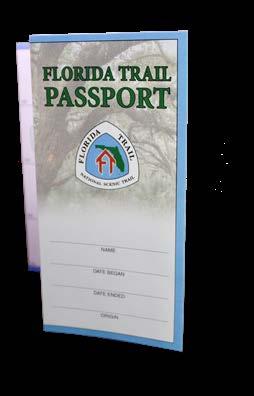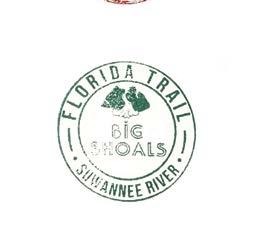
10 minute read
Prescribed Fire
Keeping Florida's Landscapes Wild
by Jeff Glenn, North Trail Program Manager
Advertisement
PRESCRIBED FIRE
Florida is the lightning capital of the United States. Centuries back, when Florida was free of human sprawl, strip malls, and gated communities, fire was a normal occurrence on the land when bolts of lightning would ignite wildfires that moved along at their own pace, stopping naturally at rivers, wetlands, or coastlines. This natural process repeated itself perpetually, and the plants and animals of the pine woods and prairies became accustomed to those frequent fires and depended on fire for their very survival. In fact, at least half of the world’s terrestrial ecosystems need fire to stay healthy. Without fire, the plants and animals unique to the original habitat maintained by fire are lost. Fox squirrels, gopher tortoises, scrub jays, red-cockaded woodpeckers, wire grass and longleaf pines are just a few of the many species which depend on fire. This natural pattern has been interrupted by development, and wildfires are now seen to pose a threat and are typically extinguished promptly. Because of public concerns, wildfires can no longer be allowed to perform this mandatory function so prescribed burning is essential to manage these plant and animal communities. Prescribed fire, also referred to as a prescribed burn or controlled burn, is fire applied in a regulated manner by a team of fire experts under specified weather conditions to help restore health to ecosystems that depend on fire. It is a tool used to reduce hazardous fuel buildups providing increased protection to people, their homes and the forest by reducing the buildup of dangerous fuels from overgrown brush and forest litter. Prescribed fire is the best way to remove this combustible debris, which helps lower the risks to people and property from fast-moving catastrophic fires, and reduces the intensity of wildfires when they do occur. Other benefits of fire include wildlife habitat improvement, disease control, range management, preservation of endangered plant and animal species and the maintenance of fire-dependent ecosystems. Prescribed fire enhances the beauty of the land by recycling nutrients back into the soil which promotes the growth of trees, wildflowers and other plants, as well as seed and fruit production. Prescribed fire is also a very cost-effective tool that land managers use to restore our natural plant and wildlife communities. Longleaf pine (Pinus palustris) is the perfect example of fire dependent tree species in Florida. Its life cycle begins when fire prepares the soil for a pine seed to germinate by clearing the ground and turning leaves,
ALMOST 70 PERCENT OF THE STATE’S 9 MILLION ACRES OF CONSERVATION LAND DEPENDS ON FIRE TO MAINTAIN ITS DIVERSITY OF PLANT AND ANIMAL LIFE.

Photo courtesy of Jeff Glenn
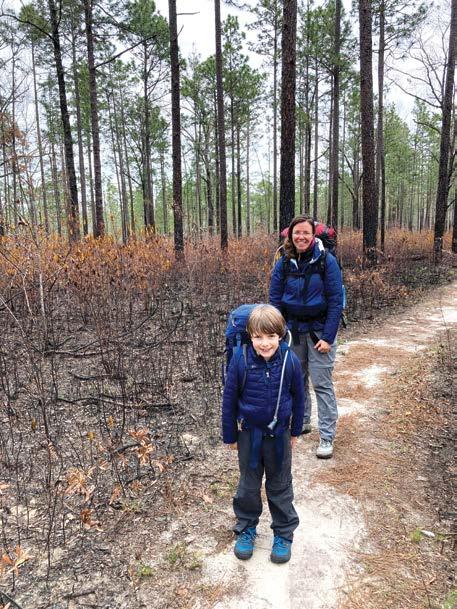
Backpackers on the trail after a recent burn in Blackwater River State Forest. Fast moving ground fires burn low to the ground without reaching the upper canopy of the forest.
The Earth is a fire planet, the only one we know. It has held fires as long as plants have lived on land. Removing fire from landscapes that have co-evolved or co-existed with it can be as ruinous as putting fire into landscapes that have no history of it. The fires we don’t see—the fires that should be there and aren’t—are an index of ecological loss, like imposing a drought on a normally lush landscape....... dropped pine needles and sticks into nutrients to be recycled back into the soil. For years, a young seedling looks like a fuzzy pipe cleaner, its bud protected by tight needles while it grows a deep taproot. A second fire frees the bud and a tree quickly grows up, above the fire line, and into safety for the next fire that comes through. With only 2 percent of southeastern longleaf pine forests still intact, prescribed fire is helping to keep this magnificent species alive. Regular prescribed fire also improves aesthetic values by maintaining open vistas. Something vitally important to the Florida Trail, regular prescribed fire provides better conditions for hunting, hiking, bicycling, and wildlife viewing. In fact, as the Florida Trail weaves its way across the state it sews together public and private land with management plans that include the use of fire to maintain the landscape and the life that it supports.

When does burning take place? Burning occurs at various times of year to produce the best mix of grasses and shrubs preferred by a wide range of wildlife species. Burning during the spring and summer usually results in an increase in grasses and other non-woody species. Burning during the fall and winter favors shrubby plants such as palmetto and gallberry. Burning generally takes place on a rotational basis by type of natural community and historical fire frequency. Similar to burning during different seasons, varying the time in between burns provides a great mix of food and cover for wildlife. An example of this would be that a burn interval for pine flatwoods could be every 18 months to four years and a sandhill every 18 months to three years.
Conducting Burns Planning for a prescribed burn starts months in advance when biologists and land managers identify areas that will benefit from prescribed fire. A detailed plan is prepared that includes a description of the natural communities and the legal boundaries, the objectives for the burn, acceptable weather parameters including smoke modeling, description of anticipated fire behavior, a list of personnel and equipment to implement and hold the burn, communications plan, and a medical plan. When the weather conditions are appropriate, and sometimes they are on very short notice, a burn authorization from the Florida Forest Service is obtained before initiating the prescribed burn. Prepping for a fire consists of establishing the perimeter fire breaks, securing and
Flames creep along the forest floor igniting fast burning pine needles.
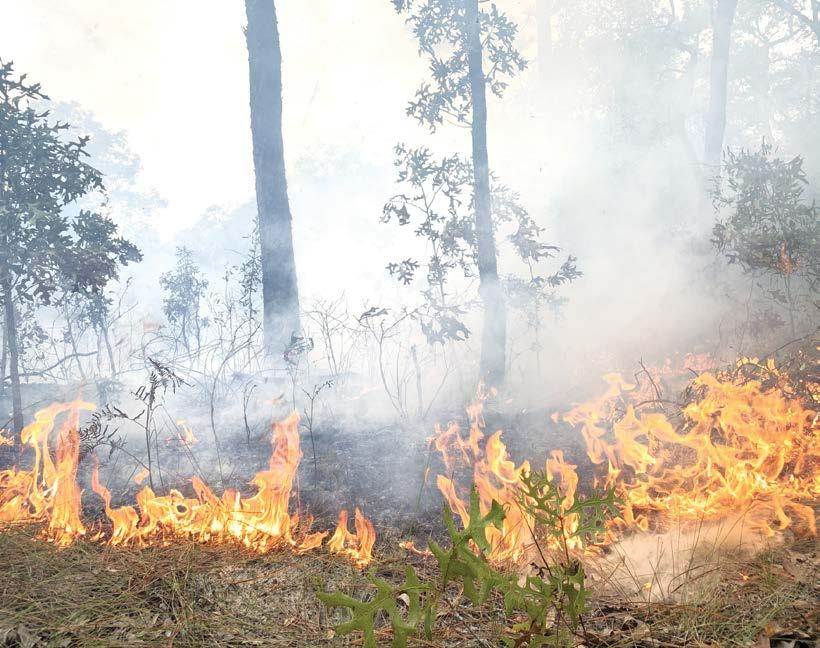

Unmanaged Forest – Fire in an unmanaged ponderosa pine forest (where fires have been repeatedly suppressed): Overcrowding can make the forest less healthy and resilient. When such a forest burns, the fire can extend into the crowns, killing large swaths of trees.
Managed Forest – Fire in a managed ponderosa pine forest (using controlled burns with or without mechanical thinning): A fire burns low through the understory, maintaining gaps between some trees that help prevent future large crown fires. THE FLORIDA FOREST SERVICE OVERSEES ONE OF THE MOST ACTIVE PRESCRIBED FIRE PROGRAMS IN THE COUNTRY. IN AN AVERAGE YEAR THE FLORIDA FOREST SERVICE WILL ISSUE APPROXIMATELY 88,000 AUTHORIZATIONS ALLOWING LANDOWNERS AND AGENCIES TO PRESCRIBE BURN OVER 2.1 MILLION ACRES.

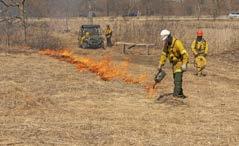
cleaning up around any infrastructure, and identifying and removing any hazards in the area. These fire breaks consist of removing all the flammable vegetation from an area twice the expected flame height at the edge of the fire. Fire breaks usually consist of a disked, plowed, or mowed line often done with heavy machinery. These are extremely common to see along the Florida Trail, oftentimes paralleling the trail, and occasionally, much to our dismay, directly over or along the trail. Smoke from burning is controlled by carefully working within the weather forecast and advanced smoke modeling tools are utilized in the planning process. When it comes to time to start the fire, different techniques are used depending on the location and size of the area to be burned. Hand-held drip torches are used when burning small areas. When drip torches are lit and inverted they drop spots of fire onto the ground using diesel fuel or kerosene. An ATV or truck-mounted torch is used in larger or less accessible units. To traverse wetter areas, torches are commonly mounted onto swamp buggies and airboats. Sometimes, due to a burn unit’s large size, aerial burning using an Aerial Ignition Device mounted on a helicopter is the best option. When all of the conditions are right to meet the desired fire behavior, the crew assembles with all their equipment in the morning for a briefing during which the burn boss gives out assignments and the organizational structure for the day. Burn bosses are individuals that are qualified to plan, organize and execute the burn. Typically, the organizational structure will consist of a holding supervisor who focuses their staff on keeping the fire within the lines and a firing supervisor who is in charge of coordinating their resources to safely and effectively ignite the fire. After the briefing, a test fire is lit. If the fire behavior during the test looks like it will meet the objectives, the operation is given a green light, and if it does not, it is shut down and put out.
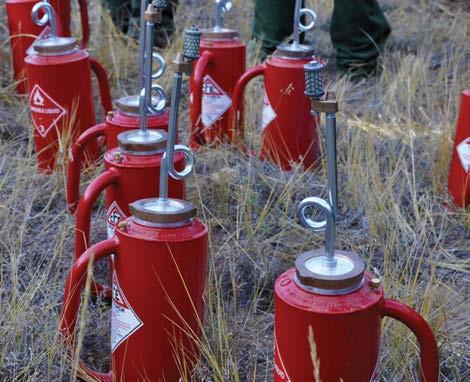
Firefighters use drip torches to ignite spots of fire along the fire line in a controlled manner. A common mixture is 60% diesel or kerosene and 40% gasoline.
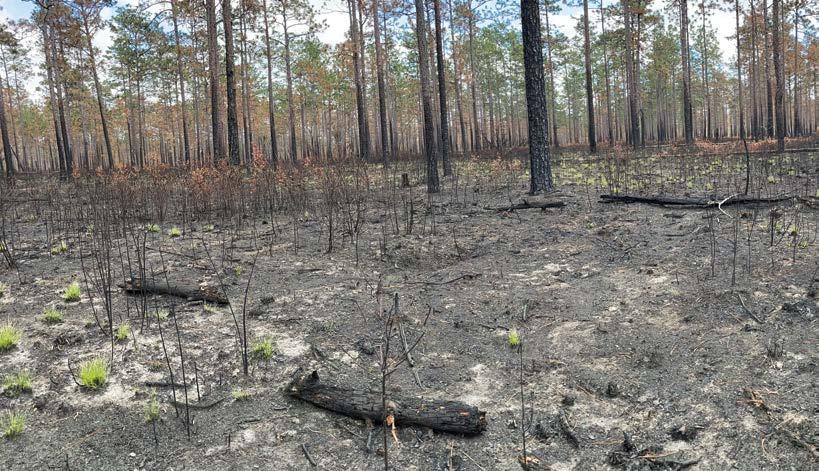
Mop Up After the fire, crews are careful to mop up, or extinguish any burning and smoking material which could be a threat to the control lines. Mop up consists of ensuring any flaming or smoking material that might threaten the containment of the fire is fully extinguished. A distance around the perimeter is usually established for complete mop up and any additional concerns are addressed. After mop up is complete, an After Action Review is completed to assess the burn operation. The crew will do final checks of the weather and the burn area, ensuring there are no holding concerns until the fire is completely out.
After the Burn If you’ve ever hiked after a controlled burn, you’ll see the immediate revival of blackened earth with new, green life. Pitcher plants, orchids, and different grasses are among key species that thrive upon fire, but there are hundreds of plant species in Florida that are fire dependent and would be lost without it. Depending on the amount of rainfall after a burn, sometimes fire history can be quickly masked with new vibrancy. With so many land management agencies burning along the Florida Trail, especially in overlapping seasons with
Photo courtesy of Florida Department of Environmental Protection
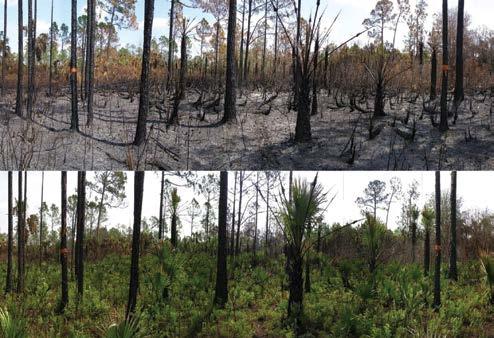
Not long after a prescribed burn, the land returns to life
the best hiking months, it is very common to experience this first hand. Routine trail maintenance often involves re-blazing sections of trail after a fresh burn and in some cases the trail can be very difficult to follow without the aid of navigational help. Hikers in Florida have the luxury of such a well organized, well funded, and well executed prescribed fire program. As hikers, we are better off for it, but more importantly, the landscapes that we use for our own recreation thrive because of it.
The future of the Florida Trail posing for a shot showing the trail after a very hot recent burn in Blackwater River State Forest.
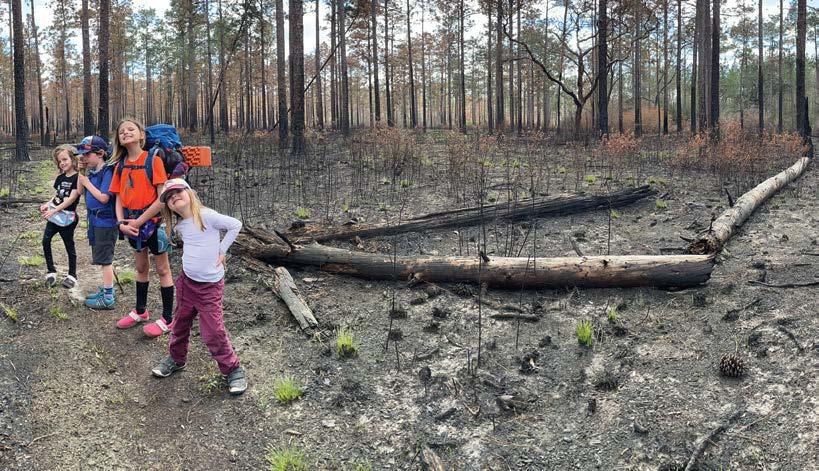
Discover the natural beauty of the Florida Trail through this pictorial journey of the trail, end to end.
With a Foreword by Jim Kern and photography by Sandra Friend and John Keatley, this keepsake book showcases the natural wonders and unique features of each section of the Florida Trail in moments captured by Sandra and John.
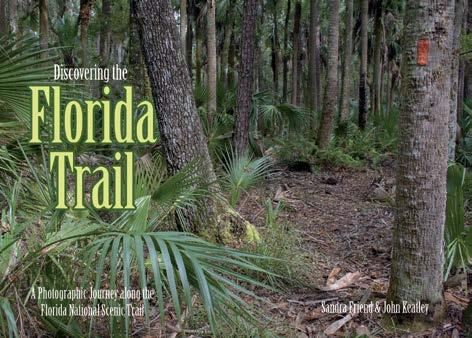
Mini coffee table book Hardcover 5x7” format 192 pages Short overviews of each trail section Photograph locations identified at the end of the book
$24.95
Available October 2020 Order at FloridaHikes.com
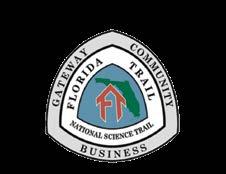
Introducing the Florida Trail Passport
VISIT OUR WEBSITE FOR DETAILS FLORIDATRAIL.ORG
